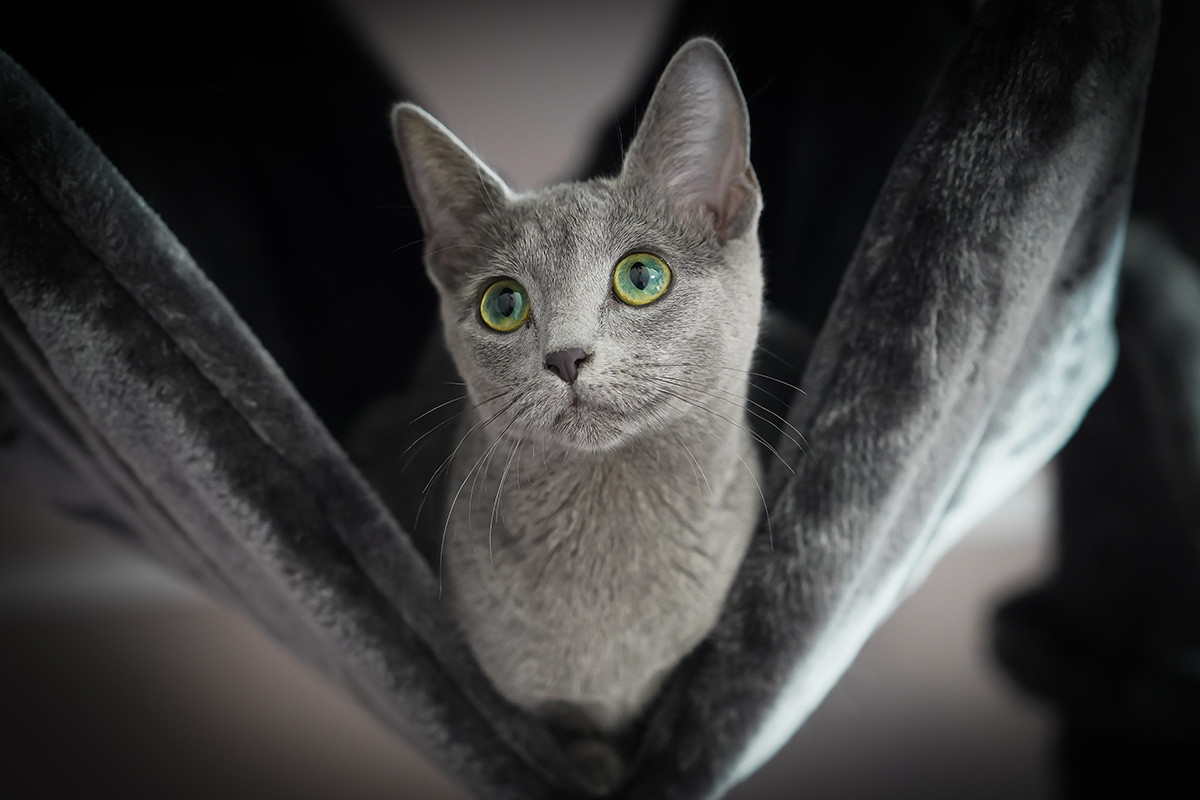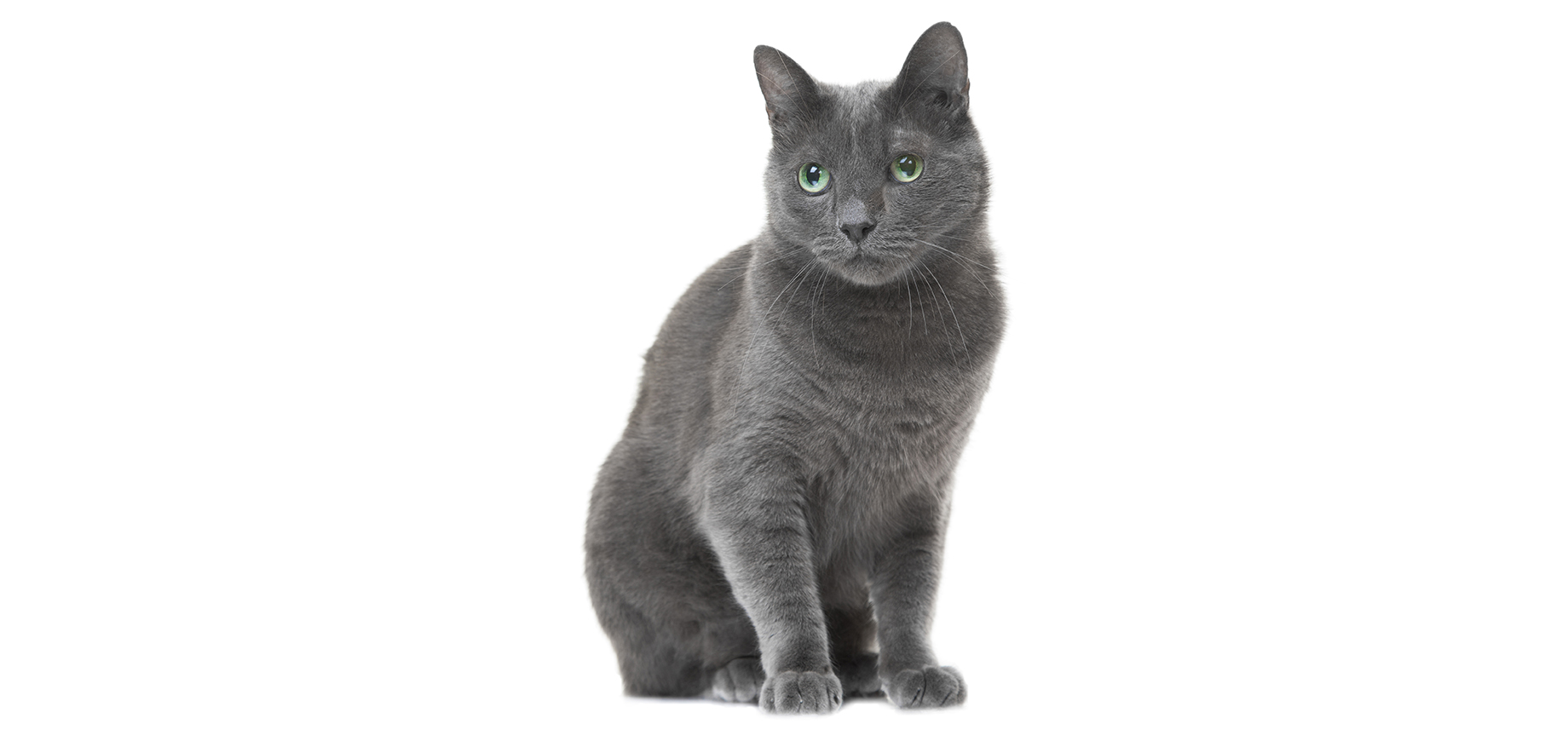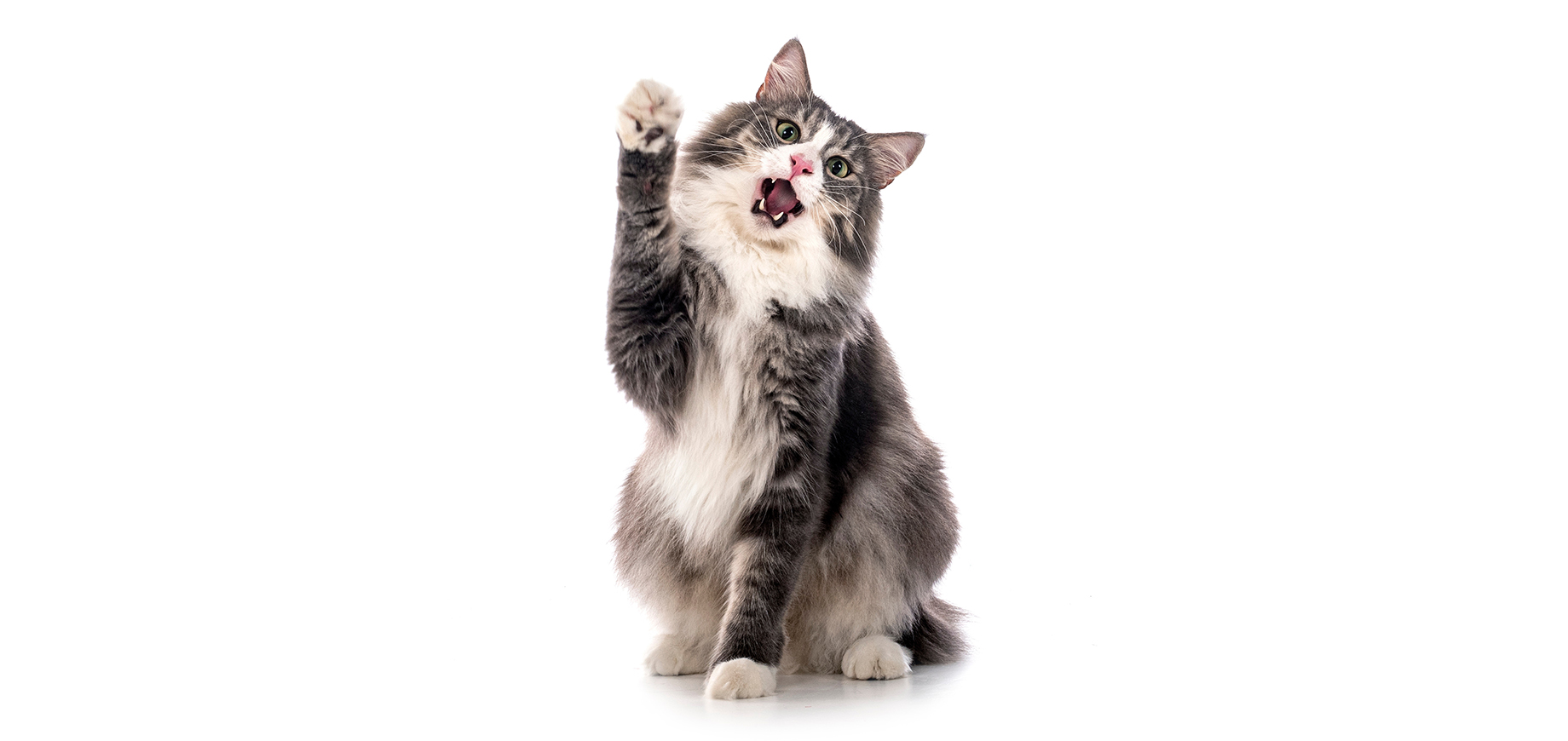Russian Blue cat - facts, temperament & care tips
The Russian Blue is an intelligent breed of cat, with a gorgeous blue-grey coat and vivid green eyes. Elegant and striking in appearance, they have quite a shy yet affectionate nature. They can form very strong bonds with their owners but may be reserved and cautious around people they don’t know. Because they’re an intelligent breed, they’re able to learn tricks and routines quickly but they also need a calm environment to retreat into. This guide explores everything you need to know about the Russian Blue cat, from their origins and unique personalities to their most distinctive traits. Discover essential care tips in relation to grooming, nutrition, and how you can keep them mentally engaged and stimulated.

The history & origins of the Russian Blue cat
The origin of the Russian Blue cat is totally shrouded in mystery, which adds to their elusive, aristocratic charm. Some people believe that this breed descended from the royal cats of Russian czars, while others say they evolved from wild cats in the Arctic, hence their thick coats that can withstand very cold climates. One theory traces the Russian Blue back to Arkhangelsk, a port city in northern Russia. It’s said that sailors brought these stunning cats to Europe back in the 19th century, where they became particularly popular in England and Scandinavia. By the late 1800s, the sought-after breed began appearing in cat shows, admired for its luxurious coat and hypnotic green eyes. Like many other breeds, it faced a severe decline during World War II, nearly becoming extinct. In order to preserve the Russian Blue, breeders turned to careful outcrossing, mainly with Siamese cats, to maintain the lineage.
What makes the Russian Blue unique?
The rare silver-blue coat
One of the most distinctive features of the Russian Blue is, without a doubt, its soft silver-blue fur. This short, dense, double-layered coat feels like velvet to the touch. Each individual hair is tipped with silver and stands slightly away from the body, creating a sort of shimmering effect that adds to the breed’s beauty. It also serves a practical purpose, providing excellent insulation against cold temperatures and harsh weather. Although the coat is dense, the fur is naturally resistant to matting and shedding, requiring minimal grooming to maintain the coat’s pristine condition.
Striking green eyes and a knowing expression
When you picture a Russian Blue cat, one of the first things that comes to mind are its captivating emerald-green eyes, a stark contrast to its blue-grey coat. But they aren’t born like this - the kittens actually have yellow eyes that change colour as they mature, adding to the mystery that surrounds this breed. Their overall facial structure gives them an air of quiet wisdom, with high cheekbones and gently sloping features contributing to their refined, aristocratic appearance. A slightly upturned mouth gives the illusion of a knowing smile, creating a quietly intelligent and observant expression.
A quiet and reserved personality
The Russian Blue cat is not an attention-seeking breed. Naturally reserved, they tend to watch from a distance and take their time to warm up to new people, giving love and affection on their own terms and timelines. But once they do begin to form a bond with someone, their loyalty runs deep and it feels like a true privilege to be their chosen human. Russian Blues love living in a calm, peaceful and predictable environment, as they don’t like loud noises or major disruptions. Their gentle nature makes them best-suited to quiet, stress-free households where they can feel totally safe and secure. They also like to be close-by, observing daily life and following their owners around as they get on with their chores. Learn more about cat behaviour here.
Understanding the Russian Blue’s behavior
Why they choose their favourite human
This breed is known for forming a deep, exclusive bond with one person. While Russian Blues may be friendly, if a little aloof, with other people, they normally reserve their genuine affection for one special human. Earning their trust takes quite a bit of time and patience, as they’re cautious and selective as a breed. As soon as they think someone is worthy of their love and affection, they’re committed for life. Expect them to follow you around the house from room to room, gently nudge their heads against your legs, and sit nearby when you’re relaxing on the sofa. This makes them an emotionally rewarding pet for individuals who appreciate a cat that offers a meaningful connection rather than showing love to everyone and anyone. Explore some different ways of socialising and playing with your Russian Blue here.
Why routine matters?
A creature of habit thrives on routine and consistency, and this is definitely the case for the blue Russian cat from day one. They’re easily unsettled by any major changes to their usual environment or normal routine, as disruption can cause them unnecessary stress and anxiety. That means feeding times, bedtimes, and playtimes should be as structured and consistent as possible, every day of the week. Owners find that this breed can display very sweet daily rituals, including waiting by the door to greet their owners from work, or waking up at the same time as their humans each morning. Some might even expect a nap or cuddle at a specific hour! If you’re confident that you can provide a stable, peaceful home for a cat that loves consistency and offers quiet companionship, then a Russian Blue could be the perfect match.
Owning a Russian Blue – What to Expect
Do they need a lot of grooming?
Even though they’ve got a thick fur coat, Russian Blues are surprisingly easy to care for and require minimum grooming. Their short fur is naturally resistant to matting and shedding, so it doesn’t take much to maintain their signature smooth and shiny coat (especially compared to long-haired cat breeds). By nature, the Russian Blue cat breed are brilliant self-groomers, keeping themselves clean with little need for intervention. To lend a helping hand so they always look their best, just enjoy brushing their velvet-like fur once a week. Removing loose hairs also reduces shedding around the home, and it can be a great activity to encourage further bonding between the cat and its owner.
Are Russian Blues prone to health issues?
Thankfully, Russian Blue cats are a healthy and robust breed, with a lifespan of 15–20 years when cared for properly. They don’t appear to have many hereditary health issues, but can experience weight-related problems if their diet and lifestyle are not managed appropriately. Portion control and regular exercise are essential factors in preventing obesity and therefore minimising risk of associated health issues. Like with all cats, regular vet check-ups are always recommended so that their overall health can be monitored, potential problems can be spotted early, and preventative treatments can be issued in good time. Owners should endeavour to keep up with vaccinations, dental care, and parasite prevention to give their beloved Russian Blue the best chances of a long and healthy life.
What should you feed a Russian Blue?
The combination of a hearty appetite and a tendency to overeat means that Russian Blues require strict portion control if they are to maintain a healthy weight as they age. Their athletic build requires a diet that’s rich in protein, so they can stay strong and energised. Feed them a Complete and Balanced diet specifically tailored to the life-stage and life-style of the cat. Wet food is far less calorie dense than dry food so replacing some of the dry food allocation with wet food can help reduce overall calories whilst providing a satisfying portion. Establish a good feeding routine from day one and avoid giving them too many treats. While it’s tempting to indulge your cherished cat, it’s best for them if they are occasionally given healthy treats, like bits of cooked chicken or fish. They should always have access to fresh water at all times, and their food and water bowls should be washed daily to prevent bacteria buildup.
How long do Russian Blues live?
- Russian Blues are known for their longevity, typically living between 15 to 20 years
- Maintaining a balanced, protein-rich diet and controlling portion sizes helps prevent obesity, which can affect how long they live for.
- The breed is playful and active by nature, so they thrive in an environment that offers interactive toys, climbing structures, and daily play sessions keeps them active and supports overall health.
- Keep your cat mentally engaged and stimulated with puzzle feeders that prevent boredom and aggression, supporting a long, happy life.
- Take your Russian Blue cat to the vets regularly for health check-ups, vaccinations, and dental care, so potential health issues that may impact their lifespan can be detected and addressed early.
Should you get a Russian Blue?
Wondering if a Russian Blue is the right cat for you? See how many of these traits align with your lifestyle:
- This breed is naturally quiet, clean, and independent. They’re well-suited to indoor life, as long as the household is calm and stable, and aren’t overly demanding.
- Their velvety coat requires minimal grooming: a weekly brushing is usually enough to keep their fur looking its best and feeling super soft.
- Like most cats, Russian Blues enjoy high vantage points. Providing cat towers, shelves, or window perches helps them feel safe, entertained, and in control of their surroundings.
- They’re an intelligent and playful breed of cat, so they need to have lots of interesting toys, feeders, and playtime.
- Despite being shy around strangers, Russian Blue cats will eventually form particularly deep and strong bonds with their chosen humans.
Conclusion
Russian Blues make wonderful pets. They’re a stunning breed with affectionate, playful, and gentle personalities, making them an ideal companion for people who want a breed of cat that is both loving and independent. These intelligent felines thrive in a calm, stable environment and enjoy interactive play as well as quiet moments with their owners. Their loyalty means they form strong bonds with their families while still valuing their alone time. If you’re thinking about adding a furry friend to your home, why not adopt a Russian Blue from a shelter or rescue? It can be an incredibly rewarding experience, as many loving cats are waiting for a second chance. By adopting, you’re not only giving a cat a safe and loving home but also helping to make room for other animals in need.
Why are Russian Blue cats so special?
Russian Blue cats are special for so many reasons. They have stunning, velvety blue-grey coats, mesmerising green eyes, and really affectionate yet independent personalities. They’re intelligent, playful, and form strong bonds with their owners. Their low-shedding fur also makes them a great choice for allergy sufferers.
Is a Russian Blue a good house cat?
Yes, Russian Blue cats make excellent house pets. They’re quiet, well-mannered, and adaptable by nature, so can live indoors quite happily. Just make sure they have lots of interactive games, tall cat towers, and puzzle feeders to keep them stimulated and active.
How much does a Russian Blue cat cost in the UK?
The price of a Russian Blue cat depends on things like breeder, location, and pedigree. Expect to pay anywhere from £400 to £1,500. Consider adopting your Russian Blue cat from a shelter or rescue centre as it’s more affordable and emotionally rewarding to give a cat a second chance.
Can Russian Blue cats be left alone?
Russian Blues can be left alone for short periods of time as they have a strong independent streak. They thrive on companionship and can get lonely and bored if left for too long. If you’re out, leave them with toys, a furry friend, or somewhere to sit with a view.









